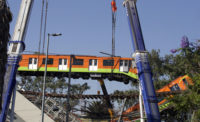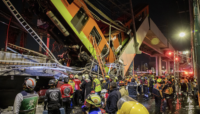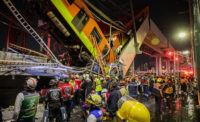Forensics Firm DNV Tapped to Probe Mexico City Subway Collapse

Norwegian risk management firm DNV will lead an independent forensic investigation into Mexico City’s subway overpass collapse that left 26 people dead and nearly 80 others injured. According to Mayor Claudia Sheinbaum, DNV’s work will parallel federal and local agency probes that are being carried out in collaboration with engineering faculty from the National Autonomous University of Mexico.
Details about the investigation’s scope and schedule are to be made public May 10. Sheinbaum said the choice of DNV, which investigated the 2010 explosion of the Deepwater Horizon oil rig in the Gulf of Mexico for the U.S. Departments of Interior and Homeland Security, will help ensure the investigation is free from politics and other influences.
“The promise that I am making to the Metro users, to the citizens, is to get to the bottom of this terrible incident,” Sheinbaum said at a May 5 press conference.
The May 3 nighttime collapse occurred on an elevated section of the city’s Line 12 subway near a suburban station southeast of the city center. Local officials say a steel girder supporting a precast concrete track bed collapsed beneath a crossing train, sending two rail cars plummeting approximately 16 ft into the median of a suburban boulevard. It was the deadliest incident on the Western Hemisphere’s second-largest subway system since a 1975 train collision killed 31 people.
Line 12 has been steeped in controversy since opening in 2012 after four years of construction by a consortium that included Mexico’s Ingenieros Civiles Asociados (ICA) and Carso Infraestructura y Construcción (CICSA), and Alstom Transport of France. Delays and technical issues reportedly drove the cost of the high-profile, politically contentious project to $2 billion, approximately 50% above the original estimate.
Two years later, an 18-month partial closure for track and structural repairs sparked a city investigation that revealed numerous instances of defective construction materials and questionable project supervision, leading to criminal prosecution of several senior project officials. In 2017, a 7.1 magnitude earthquake cracked several of Line 12’s support columns, including one in the vicinity of the May 3 collapse. According to a city report, column repairs consisted of injected resins, carbon fiber bracing and base reinforcement with rebar and concrete.
Underlying issues
Although the incident has rekindled longstanding allegations of design flaws and government corruption, consulting engineer Rozbeh Moghaddam says investigators should not overlook Mexico City’s notoriously complex subsurface conditions, particularly in the area where the collapse occurred. Moghaddam, a veteran of many Mexico City construction projects, including bored and cut-and-cover tunnels in Line 12’s western sections, says the area’s upper layer of soft, “virgin” clay sometimes defies even the most precise predictive calculations for consolidation and resulting subsidence.
“Building in that soil is a big challenge, and it’s impossible to predict how it will behave,” he says.
Though he was not involved with design of the subway’s elevated sections, Moghaddam recalls seismic modeling for the structures as being particularly challenging. Based on another project nearby, he estimates that the columns’ drilled shafts extend as much as 30m deep through the soft clay, which he likens to “a bowl of jello,” to reach more stable compressed sand layers.
Under normal conditions, Moghaddam adds, the columns would be continually subject to heavy dynamic loading from the trains, coupled with the weight of rail cars and passengers.
“But tapping that ‘bowl of jello’ with strong seismic forces such as the 2017 earthquake could cause the columns to move in any direction,” Moghaddam says, exacerbating seismic stresses on the beams.
“All these factors combined could create a lot of issues,” he adds.
Noting that buildings and other elevated subway lines in the city have survived both earthquakes and region-wide subsidence, Moghaddam suggests Line 12’s columns also may have suffered from years of insufficient inspections and maintenance.
“Columns and beams in these kinds of conditions require special attention and more periodic inspection to see what’s happening,” he adds.
Moghaddam is hopeful the forensic investigation will be free of political influences that have overshadowed Line 12’s history.
“If we have transparency and competent professionals involved, we will get some valuable lessons that could lead to new norms for building codes and infrastructure inspection in the city,” Moghaddam says. “That is my hope, anyway.”







